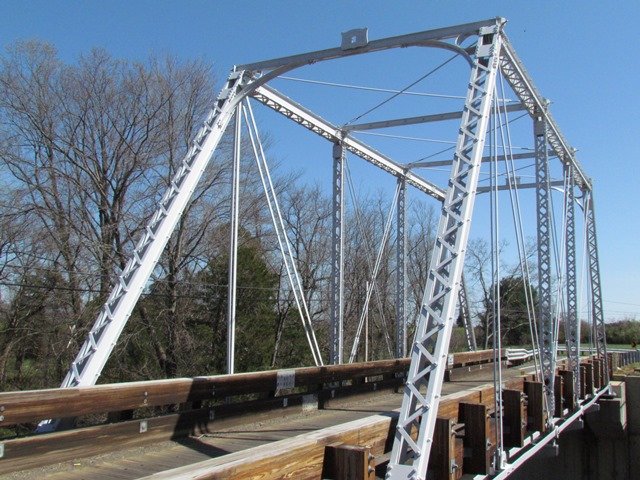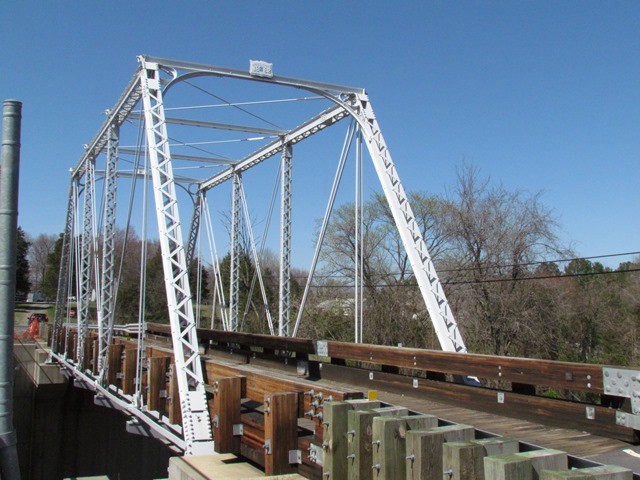We Recommend:
Bach Steel - Experts at historic truss bridge restoration.
BridgeHunter.com Phase 1 is released to the public! - Visit Now
Aden Road Bridge

Primary Photographer(s): Rick McOmber and Marc Scotti
Bridge Documented: January 6, 2012, May 11, 2012, and April 2, 2022
Rural: Prince William County, Virginia: United States
1882 By Builder/Contractor: Keystone Bridge Company of Pittsburgh, Pennsylvania
2019
78.0 Feet (23.8 Meters)
78.0 Feet (23.8 Meters)
16 Feet (4.88 Meters)
1 Main Span(s)
14340

View Information About HSR Ratings
Bridge Documentation
Bridge Status: This bridge was altered, with trusses placed on a replacement superstructure, using special hammerhead abutments designed to provide trains more room!
This bridge was originally built as a railroad bridge to carry a single railroad line of the Virginia Midland Railway over an unknown crossing. It was one of a number of bridges built by Keystone Bridge Company at this time. Between 1903 and 1904 these bridges were replaced. One of the spans was relocated, either immediately at that time, or at least before 1928, to this location at Aden Road where it became a highway bridge carrying traffic over the railroad line.
This bridge is a highly significant historic bridge. It represents an earlier era of railroad bridge construction of which very little remains. The bridge is not as rare and old as the first metal railroad bridges from the 1850s-1870s which often featured cast iron and rare truss designs such as the Bollman and Fink. However, the bridge is almost as rare since although it utilizes a more traditional wrought iron pin-connected Pratt truss design, it was still built in an earlier era of railroad bridge construction where railroad bridges were fairly lightweight in construction. Bridges from these earlier eras were so lightweight that as railroad loads rapidly increased from the 1880s into the 20th Century, nearly all of these earlier railroad bridges were replaced with much more massive railroad bridges, many of which survive today. Indeed, the Aden Road Bridge appears to be an example of this trend, since it was replaced after just over 20 years of service, a very short time. Because the bridge was likely replaced only because it was not strong enough and was still in good condition, the railroad decided to reuse the bridge as a highway bridge, where traffic loads would have been much less demanding.
As an early pin-connected Pratt truss, the Aden Road Bridge contains distinctive details, evidence of how engineers were still experimenting with different design details for truss bridges and had not moved toward the use of standardized details yet. Unusual details include the overhead lateral bracing rod connections to the ends of the struts, and the use of v-lacing instead of cover plate on the top of the top chords and end posts. Also noteworthy is the lightweight portal bracing that includes a decorative circular portal knee brace. Finally, the attachments between the floor beams and the bottom chord connections is unusual.
View Archived National Bridge Inventory Report - Has Additional Details and Evaluation

Above: Bridge before one-way couplet project.
This bridge is tagged with the following special condition(s): Trusses Converted To Decorative and Unorganized Photos
![]()
Photo Galleries and Videos: Aden Road Bridge
Bridge Photo-Documentation
Original / Full Size PhotosA collection of overview and detail photos. This gallery offers photos in the highest available resolution and file size in a touch-friendly popup viewer.
Alternatively, Browse Without Using Viewer
![]()
Bridge Photo-Documentation
Mobile Optimized PhotosA collection of overview and detail photos. This gallery features data-friendly, fast-loading photos in a touch-friendly popup viewer.
Alternatively, Browse Without Using Viewer
![]()
Post-Rehab Additional Unorganized Photos
Original / Full Size PhotosA supplemental collection of photos taken by Marc Scotti and showing the bridge as a one-way couplet that are from additional visit(s) to the bridge and have not been organized or captioned. This gallery offers photos in the highest available resolution and file size in a touch-friendly popup viewer.
Alternatively, Browse Without Using Viewer
![]()
Post-Rehab Additional Unorganized Photos
Mobile Optimized PhotosA supplemental collection of photos that are from additional visit(s) to the bridge and have not been organized or captioned. This gallery features data-friendly, fast-loading photos in a touch-friendly popup viewer.
Alternatively, Browse Without Using Viewer
![]()
Maps and Links: Aden Road Bridge
Coordinates (Latitude, Longitude):
Search For Additional Bridge Listings:
Bridgehunter.com: View listed bridges within 0.5 miles (0.8 kilometers) of this bridge.
Bridgehunter.com: View listed bridges within 10 miles (16 kilometers) of this bridge.
Additional Maps:
Google Streetview (If Available)
GeoHack (Additional Links and Coordinates)
Apple Maps (Via DuckDuckGo Search)
Apple Maps (Apple devices only)
Android: Open Location In Your Map or GPS App
Flickr Gallery (Find Nearby Photos)
Wikimedia Commons (Find Nearby Photos)
Directions Via Sygic For Android
Directions Via Sygic For iOS and Android Dolphin Browser
USGS National Map (United States Only)
Historical USGS Topo Maps (United States Only)
Historic Aerials (United States Only)
CalTopo Maps (United States Only)



